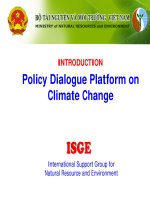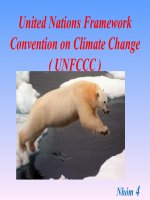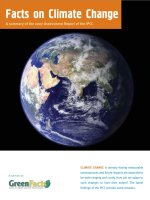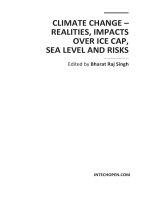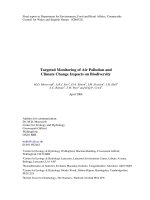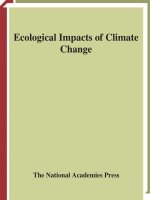Climate Change: Observed Impacts on Planet Earth
Bạn đang xem bản rút gọn của tài liệu. Xem và tải ngay bản đầy đủ của tài liệu tại đây (7.84 MB, 494 trang )
Climate Change:
Observed Impacts on Planet Earth
This page intentionally left blank
Climate Change:
Observed Impacts
on Planet Earth
Edited by
Trevor M. Letcher
Emeritus Professor
University of KwaZulu-Natal
Durban, South Africa
Elsevier
Radarweg 29, PO Box 211, 1000 AE Amsterdam, The Netherlands
Linacre House, Jordan Hill, Oxford OX2 8DP, UK
First edition 2009
Copyright © 2009 Elsevier B.V. All rights reserved
No part of this publication may be reproduced, stored in a retrieval system or transmitted in
any form or by any means electronic, mechanical, photocopying, recording or otherwise
without the prior written permission of the publisher
Permissions may be sought directly from Elsevier’s Science & Technology Rights
Department in Oxford, UK: phone (þ44) (0) 1865 843830; fax (þ44) (0) 1865 853333;
email: Alternatively you can submit your request online by
visiting the Elsevier web site at and selecting
Obtaining permission to use Elsevier material
Notice
No responsibility is assumed by the publisher for any injury and/or damage to persons or
property as a matter of products liability, negligence or otherwise, or from any use or operation
of any methods, products, instructions or ideas contained in the material herein.
British Library Cataloguing in Publication Data
A catalogue record for this book is available from the British Library
Library of Congress Cataloging in Publication Data
Climate change : observed impacts on planet Earth / edited by Trevor M. Letcher. 1st ed.
p. cm.
Includes bibliographical references and index.
ISBN 978 0 444 53301 2
1. Climatic changes. 2. Climatic changes Environmental aspects. 3. Global environmental
change. I. Letcher, T. M. (Trevor M.)
QC903.C56 2009
551.6 dc22
2009006502
ISBN: 978 0 444 53301 2
For information on all Elsevier publications
visit our website at elsevierdirect.com
Printed and bound in The Netherlands
09 10 11 12
10 9 8 7 6
5 4 3 2
1
Contents
Foreword
Preface
Contributors
Introduction
xiii
xv
xix
xxiii
Part I
Possible Causes of Climate Change
1. The Role of Atmospheric Gases in Global Warming
R. P. Tuckett
1.
2.
3.
4.
5.
6.
Introduction
Origin of the Greenhouse Effect: ‘Primary’ and ‘Secondary’ Effects
The Physical Chemistry Properties of Greenhouse Gases
The Lifetime of a Greenhouse Gas in the Earth’s Atmosphere
General Comments on Long Lived Greenhouse Gases
Conclusion
References
3
4
9
15
17
18
19
2. The Role of Widespread Surface Solar Radiation Trends
in Climate Change: Dimming and Brightening
S. Cohen
1. Introduction
2. Solar Radiation and its Measurement
3. Trends in Surface Solar Radiation or Global Dimming
and Brightening
4. The Causes of Dimming and Brightening
5. The Influence of Solar Radiation Changes (Dimming and
Brightening) on Climate
6. Conclusions
References
22
22
26
32
33
38
38
3. The Role of Space Weather and Cosmic Ray Effects
in Climate Change
L. I. Dorman
1. Introduction
2. Solar Activity, Cosmic Rays and Climate Change
44
45
v
Contents
vi
3. The Influence on the Earth’s Climate of the Solar System Moving
Around the Galactic Centre and Crossing Galaxy Arms
4. The Influence of Molecular Dust Galactic Clouds on the
Earth’s Climate
5. The Influence of Interplanetary Dust Sources on the Earth’s Climate
6. Space Factors and Global Warming
7. The Influence of Asteroids on the Earth’s Climate
8. The Influence of Nearby Supernova on the Earth’s Climate
9. Discussion and Conclusions
References
65
65
67
68
70
70
71
74
4. The Role of Volcanic Activity in Climate and Global
Change
G. Stenchikov
1.
2.
3.
4.
Introduction
Aerosol Loading, Spatial Distribution and Radiative Effect
Volcanoes and Climate
Summary
References
77
79
82
98
99
5. The Role of Variations of the Earth’s Orbital Characteristics
in Climate Change
L. J. Lourens and E. Tuenter
1.
2.
3.
4.
Introduction
Astronomical Parameters
Orbital Induced Climate Change
Conclusion
References
103
104
112
120
121
Part II
A Geological History of Climate Change
6. A Geological History of Climate Change
J. Zalasiewicz and M. Williams
1.
2.
3.
4.
5.
6.
7.
8.
9.
Introduction
Climate Models
Long Term Climate Trends
Early Climate History
Phanerozoic Glaciations
The Mesozoic Early Cenozoic Greenhouse
Development of the Quaternary Icehouse
Astronomical Modulation of Climate
Milankovitch Cyclicity in Quaternary (Pleistocene)
Climate History
127
128
129
131
132
133
134
135
136
Contents
10.
11.
12.
13.
vii
Quaternary Sub Milankovitch Cyclicity
The Holocene
Climate of the Anthropocene
Conclusions
References
137
138
138
139
139
Part III
Indicators of Climate and Global Change
7. Changes in the Atmospheric Circulation as Indicator
of Climate Change
T. Reichler
1.
2.
3.
4.
5.
6.
7.
Introduction
The General Circulation of the Atmosphere
The Poleward Expansion of the Tropical Circulation
The Decreasing Intensity of the Tropical Circulation
Emerging Mechanisms
Connection to Extratropical Circulation Change
Outstanding Problems and Conclusions
References
145
147
149
155
155
159
160
162
8. Weather Pattern Changes in the Tropics and
Mid-Latitudes as an Indicator of Global Changes
R. M. Trigo and L. Gimeno
1.
2.
3.
4.
Introduction
Observed Changes in Extra Tropical Patterns
Changes in Tropical Patterns
Conclusion
References
165
166
170
178
179
9. Bird Ecology as an Indicator of Climate and Global
Change
W. Fiedler
1. Introduction
2. Indicators of Change
3. Conclusion
References
181
182
193
193
10. Mammal Ecology as an Indicator of Climate Change
M. M. Humphries
1. Introduction: A Primer on Mammal Thermoregulation and Climate
Impacts
197
Climate Change:
Observed Impacts on Planet Earth
Contents
viii
2. Demonstrated Impacts of Climate Change on Mammals
3. Linking Time and Space in Mammal Climate Responses
References
199
210
211
11. Climate Change and Temporal and Spatial Mismatches
in Insect Communities
S. L. Pelini, K. M. Prior, D. J. Parker, J. D. K. Dzurisin, R. L. Lindroth
and J. J. Hellmann
1.
2.
3.
4.
5.
6.
Introduction
Direct Effects of Climate Change on Insects
Host Plant Mediated Effects on Insects
Predator Mediated Effects on Insect Populations
Climate Change and Insect Pests
Conclusion
References
215
217
219
222
225
226
227
12. Sea Life (Pelagic and Planktonic Ecosystems) as an
Indicator of Climate and Global Change
M. Edwards
1. Pelagic and Planktonic Ecosystems
2. Observed Impacts on Pelagic and Planktonic Ecosystems
3. Conclusion and Summary of Key Indicators
References
233
237
246
248
13. Changes in Coral Reef Ecosystems as an Indicator
of Climate and Global Change
M. J. Attrill
1.
2.
3.
4.
Introduction
Tropical Coral Reef Ecosystems
The Associated Fauna of Coral Reefs
Conclusion
References
253
254
258
260
260
14. Changes in Marine Biodiversity as an Indicator
of Climate Change
B. Worm and H. K. Lotze
1.
2.
3.
4.
Introduction
Climate Change and the Oceans
Effects of Climate Change on Biodiversity
Cumulative Impacts and Indirect Effects of Climate
Change
5. Biodiversity as Insurance against Climate Change
Impacts
263
264
265
272
274
Contents
6. Conclusions
References
ix
275
276
15. Intertidal Indicators of Climate and Global Change
N. Mieszkowska
1.
2.
3.
4.
5.
Introduction
Climate Change and Biogeography
Mechanisms
Additional Impacts of Global Change
Conclusions
References
281
283
289
291
292
292
16. Plant Ecology as an Indicator of Climate and Global
Change
M. D. Morecroft and S. A. Keith
1.
2.
3.
4.
5.
6.
Introduction
Changes in Phenology
Changes in Distribution
Community Composition
Plant Growth
Conclusions
References
297
299
300
301
302
303
304
17. The Impact of Climate and Global Change on Crop
Production
G. R. Dixon
1.
2.
3.
4.
5.
6.
Introduction
Impact on Plant Growth and Reproduction
Scale of the Problems
Climate Change Models
Winners and Losers
Adaptation
References
307
308
313
314
315
320
322
18. Rising Sea Levels as an Indicator of Global Change
R. Gehrels
1.
2.
3.
4.
5.
Introduction
Is Sea Level Rising?
Why is Sea Level Rising?
Are Contemporary Rates of Sea level Rise Unusual?
Conclusion
References
325
325
328
333
334
334
Contents
x
19. Sea Temperature Change as an Indicator of Global
Change
M. J. Attrill
1. Introduction: Role of Ocean, Mechanisms and Correction of Bias
2. Long Term Trends in Sea Temperature: The Historical Context
3. Global and Regional Patterns of Sea Temperature over the Last
100 150 Years
4. Conclusion: Anthropogenic Influence
References
337
341
343
345
346
20. Ocean Current Changes as an Indicator of Global Change
T. Kanzow and M. Visbeck
1.
2.
3.
4.
5.
Introduction
The Variable Ocean
Oceanographers’ Tools
The Atlantic Meridional Overturning Circulation
The AMOC’s Role in Heat Transport, Oceanic Uptake of Carbon
and Ventilation of the Deep Ocean
6. Can we Detect Changes in the AMOC? Is the AMOC Changing
Already?
7. Conclusion
References
349
350
351
353
357
361
362
364
21. Ocean Acidification as an Indicator for Climate Change
C. Turley and H. S. Findlay
1.
2.
3.
4.
5.
6.
7.
Introduction
Evidence from Observations
Model Predictions of Future Change
Impacts
Biogeochemical Cycling and Feedback to Climate
Adaptation, Recovery and Mitigation
Conclusion
References
367
370
374
374
381
383
385
387
22. Ice Sheets: Indicators and Instruments of Climate Change
D. G. Vaughan
1.
2.
3.
4.
Introduction
Sea level and Ice
How Ice Sheets Work
Summary
References
391
391
394
398
399
Contents
xi
23. Lichens as an Indicator of Climate and Global Change
A. Aptroot
1.
2.
3.
4.
5.
6.
Introduction
Predicted Effects
Observed Effects
Uncertain Effects
Habitats with Vulnerable Lichens
Conclusion
References
401
402
402
403
405
407
408
24. Coastline Degradation as an Indicator of Global Change
R. J. Nicholls, C. Woodroffe and V. Burkett
1.
2.
3.
4.
5.
6.
7.
8.
9.
Introduction
Sea Level Rise and Coastal Systems
Climate Change and Global/Relative Sea Level Rise
Increasing Human Utilisation of the Coastal Zone
Climate Change, Sea Level Rise and Resulting Impacts
Recent Impacts of Sea Level Rise and Climate Change
Global Warming and Coasts at Latitudinal Extremes
The Challenge to Understand Contemporary Impacts
Concluding Remarks
References
409
411
412
413
415
416
418
420
421
422
25. Plant Pathogens as Indicators of Climate Change
K. A. Garrett, M. Nita, E. D. De Wolf, L. Gomez and A. H. Sparks
1. Introduction
2. Climate Variables and Plant Disease
3. Evidence that Simulated Climate Change Affects Plant Disease
in Experiments
4. Evidence that Plant Disease Patterns have Changed due to
Climate Change
References
425
426
Index
439
430
431
436
This page intentionally left blank
Foreword
The 2007 Assessment of the Intergovernmental Panel on Climate Change
drew two substantially new conclusions which have had a marked effect on
policymakers. The first was that current climate change is ‘unequivocal’ and
is due largely to emissions of greenhouse gases resulting from human activity.
The second was that the effects of this observed global warming can
now be detected on every continent in the form of altered hydrology and
biology. The positive response by policymakers was due not only to the
higher levels of certainty surrounding the issue, but that empirically observed
evidence now supported the simulation modelling of the future that had generally characterised the previous three IPCC assessments. Now, the policymakers could say, we are beginning to see come true just what the scientists
had been predicting.
The concreteness of that case is examined in great detail in this book. Its
chapters on the various processes that may affect the world’s climate and on
the detected changes in atmospheric, ocean and terrestrial (especially
biological) systems serve to unfold this scientific narrative for the reader.
But the book’s strength lies in this not just being a summary of the IPCC
because many of its authors were not involved extensively in the 2007 assessment, and thus they are able both to evaluate afresh the nature of the evidence
and to bring new perspectives to bear on the issue.
As the editor says in his Introduction, if there ever was doubt about
climate change then this should be dispelled in this book. I would add that
if there ever was a case to be made for action, then this case has been made
here in this volume and others like it which has followed the IPCC 2007
assessment. It is clear that stringent and immediate action is needed to curb
greenhouse emissions and that we also need to start, now, on building our
capacity to adapt to climate change impacts. It will take both massive mitigation and adaptation to meet the challenge of climate change.
Martin Parry
Visiting Professor,
Centre for Environmental Policy,
Imperial College London
Co-Chair Working Group II Assessment on Impacts,
Adaptation and Vulnerability,
Intergovernmental Panel on Climate Change 2007
xiii
This page intentionally left blank
Preface
Despite the many signs of global warming, global dimming, and changes to
the climate, there are still many people who will not accept that something
very ominous is taking place. This book is a very positive contribution to
the problem. Professor Letcher is to be congratulated for inspiring so many
world class experts into compiling such a wide reaching volume aimed at
assessing and accounting for our changing climate. The book on climate
change answers the basic questions: what can possibly cause global warming
and climate change; and what evidence do we have that such changes are
taking place?
The first five chapters focus on the possible causes of climate change with
the first salvo being fired by Richard Tuckett who has put forward an eloquent
chapter on the possible effects of anthropogenic greenhouse gases on the climate. Although we cannot prove conclusively that there is a cause-and-effect
correlation between rising global temperature and atmospheric carbon dioxide
concentration, the correlation over the past 100 years is very convincing.
To put the whole idea of climate change in perspective, there is a chapter
on a Geological History of Climate Change. In this chapter Jan Zalasiewicz
and Mark Williams traces the climate of the Earth over the past billion years.
One really needs to understand the past in order to assess the present and
indeed to attempt to predict the future consequences of climate change.
The remaining 19 chapters focus on a variety of global changes brought
about by climate change. These include detailed scientific observations on
weather patterns, plants and plant pathogens, lichens, bird, insect and animal
ecology, sea temperature and ocean currents, rising sea levels and coastal
erosion, and ice sheets. The chapter by Geoff Dixon on the impact of climate
change on crop production is highly relevant, particularly in the developing
world.
The evidence from the book that global warming and all the resultant
changes, is due to human activity makes one appreciate just how fragile
our environment is as we spin round the sun and move through space with
our galaxy and all the other galaxies. Life was created on earth in an environment with more or less fixed physical properties which include: the level of
radiation from the sun; the degree of shielding of the sun’s radiation by the
atmospheric gases; the level of the Earth’s internal heat; and above all, the
properties of the atmosphere such as pressure, temperature and gaseous composition. The Earth and its atmosphere form a very fragile system, which is in
equilibrium with the life forms it supports. These conditions have developed
xv
xvi
Preface
over billions of years and any disturbance of this equilibrium could spell disaster to life on earth. The rapid rise of the world’s human population, together
with the need for more energy, protein rich food, and greater wealth, has led
us to a situation in which this equilibrium is now being seriously threatened.
This is not the first time that life on Earth has been responsible for altering
the composition of the atmosphere. About 2.45 billion years ago enormous
numbers of cyanobacteria began changing the composition of the atmosphere
by producing oxygen and hence ozone, and together with later plant life,
photosynthetically produced most of the oxygen we now have in our atmosphere. This change led to the demise of many life forms which were unable
to live or adapt to an atmosphere rich in oxygen.
Climate Change can be considered as a sequel to Professor Letcher’s
recent book Future Energy (published in 2008, also by Elsevier). Our quest
for more energy is strongly linked to the problems of climate change and
the bottom line is that we must reduce our dependency on fossil fuels and
move to more sustainable and cleaner forms of energy which do not produce
carbon dioxide. Both books pose huge questions which this and future generations must focus on.
As the main causes of global warming and climate change are largely
chemical in nature it is right that the International Union of Pure and Applied
Chemistry should take a lead in highlighting the problem with the hope of
directing and influencing governments and world leaders to take a stand in
reducing the burning of fossil fuels and the manufacture of other greenhouse
gases. IUPAC has supported Professor Letcher’s work and the production of
the book is indeed a Project done through its Chemistry and the Environment
Division (V1). Climate Change confirms IUPAC’s commitment, as a leading
scientific union, to pure and applied science.
This book supports the work done by the Intergovernmental Panel on
Climate Change and presents experimental evidence for both the cause of
the problem and the problem itself, with little attempt at computer modelling
and predicting possible future scenarios. The evidence in this book should
alert an anxious population of what is happening and the next step is to close
ranks and change our ways. Climate Change with its 25 chapters is an excellent source book and will be an important guide for all who wish to know the
truth of global warming, global dimming and climate change.
The conclusions to be derived from this book make it abundantly clear that
we are challenged to significantly reduce the greenhouse gas emissions from
human activity. This is not an easy task especially with our rapidly increasing
population and the need for more energy to fuel our growing economies and
associated wealth generating projects. Our future and that of our grandchildren will be severely compromised unless we take heed and act now. I believe
this book is a shining light in the drive to educate the public in what is really
taking place in the world of climate change and will be a beacon for many
years to come.
Preface
xvii
I warmly thank Professor Letcher and his team for making such a phenomenal contribution to one of our greatest challenges. Climate change is a crisis
which affects all living species. We have only one globe; let us all care for it.
Professor Piet Steyn
Past President of the International Union of Pure and Applied Chemistry
Department of Chemistry and Polymer Science
Stellenbosch University
Stellenbosch
This page intentionally left blank
Contributors
Numbers in parentheses indicate the pages on which the authors’ contributions begin.
Richard P. Tuckett (3), School of Chemistry, University of Birmingham, Edgbaston,
Birmingham B15 2TT, United Kingdom
Shabtai Cohen (21), Department of Environmental Physics and Irrigation. Institute of
Soil, Water and Environmental Sciences, Agricultural Research Organization,
The Volcani Centre, P.O. Box 6, Bet Dagan 50250, Israel
Lev I. Dorman (43), Head of Cosmic Ray and Space Weather Center with Emilio
Se`gre Observatory, Tel Aviv University, TECHNION and Israel Space Agency,
P.O. Box 2217, Qazrin 12900, Israel and Chief Scientist of Cosmic Ray
Department of IZMIRAN Russian Academy of Science, Troitsk 142090,
Moscow region, Russia
Georgiy Stenchikov (77), Department of Environmental Sciences, Rutgers University,
New Brunswick, New Jersey 08901 855, USA
Lucas J. Lourens (103), Department of Earth Sciences, Faculty of Geosciences,
Utrecht University, Budapestlaan 4, 3584 CD Utrecht, The Netherlands
Erik Tuenter (103), Institute for Marine and Atmospheric Research Utrecht (IMAU),
P.O. Box 80,000, 3508 TA Utrecht, The Netherlands
Jan Zalasiewicz (127), Department of Geology, University of Leicester, University
Road, Leicester LE1 7RH, United Kingdom
Mark Williams (127), Department of Geology, University of Leicester, University
Road, Leicester LE1 7RH, United Kingdom
Thomas Reichler (145), Department of Meteorology, University of Utah, Salt Lake
City, Utah 84112 0110, USA
Ricardo M. Trigo (165), Centro de Geofisica da Universidade de Lisboa, IDL,
Faculty of Sciences, University of Lisbon, Campo Grande, Ed C8, Piso 3, 1749
016 Lisbon, Portugal
Luis Gimeno (165), Departamento de Fı´sica Aplicada, Faculty of Sciences, University
of Vigo, 32004 Ourense, Spain
Wolfgang Fiedler (181), Max Planck Institute for Ornithology, Vogelwarte
Radolfzell, Schlossallee 2, D 78315, Radolfzell, Germany
Murray M. Humphries (197), Department of Natural Resource Sciences, McGill
University, Ste Anne de Bellevue, Quebec, Canada H9X 3V9
Shannon L. Pelini (215), Department of Biological Sciences, University of Notre
Dame, Notre Dame, Indiana 46556, USA
Kirsten M. Prior (215), Department of Biological Sciences, University of Notre
Dame, Notre Dame, Indiana 46556, USA
xix
xx
Contributors
Derrick J. Parker (215), Department of Biological Sciences, University of Notre
Dame, Notre Dame, Indiana 46556, USA
Jason D.K. Dzurisin (215), Department of Biological Sciences, University of Notre
Dame, Notre Dame, Indiana 46556, USA
Jessica J. Hellmann (215), Department of Biological Sciences, University of Notre
Dame, Notre Dame, Indiana 46556, USA
Richard L. Lindroth (215), Department of Entomology, University of Wisconsin,
Madison, Wisconsin, USA
Martin Edwards (233), Sir Alister Hardy Foundation for Ocean Science, Citadel Hill,
The Hoe, Plymouth PL1 2PB, United Kingdom and Marine Institute, University of
Plymouth, Drake Circus, Plymouth PL4 8AA, United Kingdom
Martin J. Attrill (253), Marine Biology and Ecology Research Centre, Marine
Institute, University of Plymouth, Drake Circus, Plymouth PL4 8AA, United
Kingdom
Boris Worm (263), Biology Department, Dalhousie University, Halifax, Nova Scotia,
Canada B3H 4J1
Heike K. Lotze (263), Biology Department, Dalhousie University, Halifax, Nova
Scotia, Canada B3H 4J1
Nova Mieszkowska (281), Marine Biological Association of the UK, The Laboratory,
Citadel Hill, Plymouth PL1 2PB, United Kingdom
Michael D. Morecroft (297), NERC Centre for Ecology and Hydrology, Crowmarsh
Gifford, Wallingford OX10 8 BB, United Kingdom
Sally A. Keith (297), Centre for Conservation Ecology and Environmental Change,
Bournemouth University, Fern Barrow, Poole BH12 5BB, United Kingdom
Geoffrey R. Dixon (307), Centre for Horticulture and Landscape, School of Biological
Sciences, Whiteknights, The University of Reading, Reading, Berkshire RG6 6AS,
United Kingdom
Roland Gehrels (325), School of Geography, University of Plymouth, Drake Circus,
Plymouth PL4 8AA, United Kingdom
Martin J. Attrill (337), Marine Biology and Ecology Research Centre, Marine Institute,
University of Plymouth, Drake Circus, Plymouth PL4 8AA, United Kingdom
T. Kanzow (349), National Oceanographic Centre, Empress Dock, Southampton SO14
3ZH, United Kingdom; Leibniz Institute of Marine Sciences, Kiel, Germany
M. Visbeck (349), Leibniz Institute of Marine Sciences, Kiel, Germany
Carol Turley (367), Plymouth Marine Laboratory, Prospect Place, The Hoe, Plymouth
PL1 3DH, United Kingdom
Helen S. Findlay (367), Plymouth Marine Laboratory, Prospect Place, The Hoe,
Plymouth PL1 3DH, United Kingdom
David G. Vaughan (391), British Antarctic Survey, Natural Environment Research
Council, Madingley Road, Cambridge CB3 0ET, United Kingdom
Contributors
xxi
Andre Aptroot (401), ABL Herbarium, Gerrit van der Veenstraat 107, NL 3762 XK
Soest, The Netherlands
Robert J. Nicholls (409), School of Civil Engineering and the Environment and the
Tyndall Centre for Climate Change Research, University of Southampton,
Southampton SO17 1BJ, United Kingdom
Colin Woodroffe (409), School of Earth and Environmental Sciences, University of
Wollongong, NSW 2522, Australia
Virginia Burkett (409), U.S. Geological Survey, 540 North Courthouse Street, Many,
LA 71449 USA
Karen A. Garrett (425), Department of Plant Pathology, Kansas State University,
Manhattan, Kansas 66506, USA
M. Nita (425), Department of Plant Pathology, Kansas State University, Manhattan,
Kansas 66506, USA
E.D. De Wolf (425), Department of Plant Pathology, Kansas State University,
Manhattan, Kansas 66506, USA
L. Gomez (425), Department of Plant Pathology, Kansas State University, Manhattan,
Kansas 66506, USA
A.H. Sparks (425), Department of Plant Pathology, Kansas State University,
Manhattan, Kansas 66506, USA
This page intentionally left blank
Introduction
The phrases CLIMATE CHANGE and GLOBAL WARMING and more
recently GLOBAL COOLING are now part of our lives and rarely does a
day go by without a mention in the press or on the radio of the possible causes
of climate change and its consequences. Climate change has come upon us
in a relatively short space of time and is accelerating with alarming speed.
It is perhaps the most serious problem that the civilized world has had to
face. It is the subject of major international co-operation through the Intergovernmental Panel on Climate Change (IPCC) which was set up in 1988
by the World Meteorological Organization and the United Nations Environment Programme. The IPCC has reported its findings in 1990, 1996, 2001
and 2007. The intention of this book is not to compete with the IPCC reports
but to offer support through a different approach. This book does not focus on
predicting the outcomes of climate change but presents both the facts relating
to the possible causes of climate change and the evidence that climate and
global changes are taking place.
In spite of all the publicity and coverage and indeed in the face of real evidence, there are many dissenting voices who either do not accept that climate
change is taking place or that anthropogenic gases and compounds, such as
carbon dioxide, are responsible for the major effect. One of the aims of this
book is to counteract these comments and to present the evidence for climate
change, in an unemotional, non-political, readable and scientific manner.
The book is divided into 25 chapters, each one written by an expert in the
field. Five chapters have been devoted to answering the questions surrounding
possible causes of climate change and the role being played by anthropogenic
gases, compounds and particles. The five include solar effects, space weather,
volcanic activity, variations in the earth’s orbit, the role of cosmic radiation
and the effect of changes in atmospheric carbon dioxide, nitrogen oxides,
water vapour and man made gases such as freons.
To put climate change into perspective, there is a chapter on the geological
history of the earth’s climate. There is evidence of slow changes in climate,
taking place over millions of years, and also of abrupt reorientations of the
Earth’s climate, the latter perhaps foreshadowing the way climate is responding to the present human activity.
If there ever was doubt about whether global and climate changes are taking place or not, then the last section of nineteen chapters should put pay to
such thinking. These chapters give expert interpretations of the changes taking
place in diverse areas such as weather patterns; bird, mammal and insect ecology; sea life and marine biodiversity; the inter-tidal zone; impacts on food
xxiii



